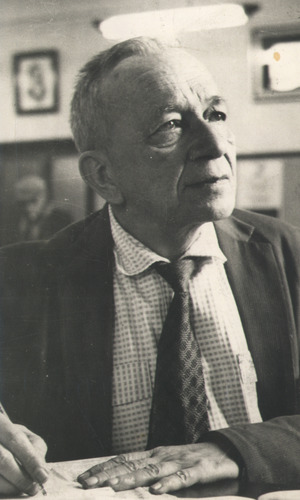Mário Quintana facts for kids
Mário de Miranda Quintana (born July 30, 1906 – died May 5, 1994) was a famous Brazilian writer and translator. He is known for his beautiful poems.
People called him the "poet of simple things." His writing style was special. It often used irony (saying one thing but meaning another). His poems were also very deep and well-written. Mário Quintana often wrote about big ideas like growing up, memories, and time passing. Besides writing poems, he also worked as a journalist. He translated many books into Portuguese, like Mrs. Dalloway by Virginia Woolf.
Contents
Life and Achievements of Mário Quintana
Early Life and Education
Mário Quintana was born in a town called Alegrete. His parents were Celso de Oliveira Quintana de Miranda and Virginia. He went to school there when he was young. In 1919, he moved to Porto Alegre to study at a Military School. This is where he started to publish his first writings. Later, he began working for a publishing company called Editora Globo.
A Poet of Simple Things
Mário Quintana was known for writing about everyday life. His poems had a unique style. They were often full of irony and deep thoughts. He also wrote very carefully, making sure his words were perfect. For most of his life, he worked as a journalist. He also translated more than 130 books from other languages into Portuguese. These included In Search of Lost Time by Marcel Proust and Mrs. Dalloway by Virginia Woolf.
Beginning His Writing Career
In 1940, Mário Quintana released his first book of poems. It was called A Rua dos Cataventos (The Windmills Street). This book marked the start of his career as a poet and writer. He even wrote books for children!
In 1953, he started writing for a newspaper called Correio do Povo. He had his own column about culture. This column came out every Saturday. He worked there until 1977.
Awards and Recognition
In 1966, when Mário Quintana turned sixty, a special book was published. It was called Poetic Anthology. This book had sixty of his poems. Famous writers like Rubem Braga and Paulo Mendes Campos helped put it together. Because of this book, he was praised by the Brazilian Academy of Letters. He also won the Fernando Chinaglia Prize for the best book of the year.
Ten years later, in 1976, Mário Quintana turned seventy. The government of Rio Grande do Sul gave him a special award. It was called the Medal Negrinho do Pastoreio. In 1980, he received the Machado de Assis prize. This award from the Brazilian Academy of Letters honored all his amazing work.
A Solitary Life
Mário Quintana never got married or had children. He lived a quiet life. For many years, from 1968 to 1980, he lived in hotels. One of these was the Hotel Majestic in Porto Alegre.
There was a story that spread online about him. It said that a famous football player, Paulo Roberto Falcão, helped him when he had money problems. The story claimed Quintana was evicted from his hotel. But this wasn't true. Falcão did invite Quintana to stay at his hotel, the Hotel Royal. This happened after Falcão heard Quintana had surgery. At that time, Quintana was staying at another hotel and was not having money troubles. Falcão simply wanted to help a respected artist.
Mário Quintana tried three times to join the Brazilian Academy of Letters. But he never got enough votes. Even though he was promised he would be accepted if he tried again, he refused to apply a fourth time. He passed away in Porto Alegre when he was 87 years old.
Major Works
- A Rua dos Cataventos, 1940
- Canções, 1946
- Sapato Florido, 1948
- O Aprendiz de Feiticeiro, 1950
- Espelho Mágico, 1951
- Inéditos e Esparsos, 1953
- Poesias, 1962
- Caderno H, 1973
- Apontamentos de História Sobrenatural, 1976
- Quintanares, 1976
- A Vaca e o Hipogrifo, 1977
- Esconderijos do Tempo, 1980
- Baú de Espantos, 1986
- Preparativos de Viagem, 1987
- Da Preguiça como Método de Trabalho, 1987
- Porta Giratória, 1988
- A Cor do Invisível, 1989
- Velório Sem Defunto, 1990
- Água, 2001
See also
 In Spanish: Mário Quintana para niños
In Spanish: Mário Quintana para niños


